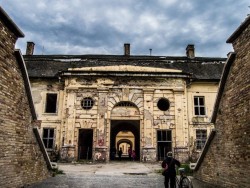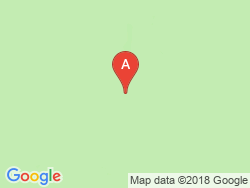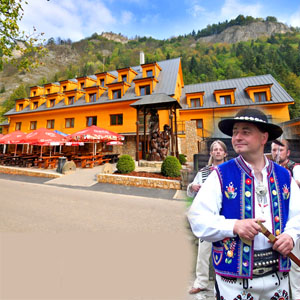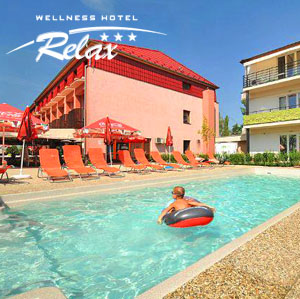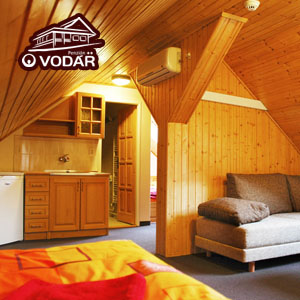FORTRESS KOMÁRNO
back to Attractions KomárnoKomárno - area: Danubian Lowland, Zitny ostrov - region: Danubeland
Type of interest: National cultural monuments
The fortification system in Komárom is a unique military complex, its significance spreading over the borders of Hungary and Slovakia.
In the 19th century it was the most powerful and the biggest construction of the Austro-Hungarian Monarchy. Its invincibility is commemorated by the statue of the “Stone Virgin“ decorating the Western Bastion of the New Fortress and the sign undrneath which says: NEC ARTE NEC MARTE – neither by trick nor force. These words characterise precisely the whole fortification system which was perfect and impregnable in its time.
The history of building the Old and New Fortresses
Komárom, even in the old times, was a well-protected area thanks to the rivers and marshes that surrounded the town. Archaeological findings prove the presence of the Celtic, Roman and Avar tribes. Anonymus mentions first in his work the Gesta Hungarorum that in the territory of the present Old Fortress in the 10th century the first earthen fort was built. On the eastern side it was protected by the River Vaag-Danube, on the southern side by the River Danube and on the western side it was protected by a moat that connected the two rivers.
Due to the strategically excellent position of the fortress and the work on the fortress which was carried out in time, the castle in Komárom withstood the sieges of the Tartars. In 1265 Adalbert IV provided the citizens of Komárom with the same rights and priviliges as the citizens of Buda and the settlement became a town. In 1317 Matthias Csák defended the fortress against king Robert Charles.
On 22nd February 1440 Ladislavus V, Czech and Hungarian king was born in the fortress under adventurous conditions. After his death, Matthias Korvin was chosen king of Hungary who had magnificent renaissance palaces built in Komárom (as well as in Buda and in Visegrád). This period was the golden age in the history of the fortress. The architects were primarily interested in artistic purposes regarding the building and the construction of the fortress so the military views got secondary importance. King Matthias frequently stayed in the castle with the greatest of pleasure. Unfortunately, there is no proof or any artifacts from the turbulent events of the next period.
At the end of the 15th century the medieval castles could no longer resist the modern artilleries. The invention of the cannon changed the basic conception of fortress and castle building all over the world. In case of Komárom the necessity to modernise the fortress became evident in 1527. In that year emperor Ferdinand I besieged the fortress and invaded it after only a half-day siege. He ordered the renovation of the destroyed walls and in order to protect the fortress better, he had ramparts built between the fortress and the town. He appointed Decius, an Italian architect with the supervision of the work which was finished in 1528.
In 1529 under the leadership of Suleiman II the Turkish troops succeeded in invading the fortress for a short time as they besieged an empty fortress as the emperor’s troops left the fortress. After getting the fortress back in 1530, emperor Ferdinand I had the destroyed parts of the fortress renovated. In 1535 though, he was forced to give the fortress to the Turks as a mortgage.
When Buda was captured by the Turks in 1541, Ferdinand I started to improve the fortress. He got the castle back in 1544 and ordered its reconstruction. He assigned Pietro Ferrabosco to preparing the plans of the fortress who suggested a fort in the shape of more angles as it corresponded well to the geographical position of the area. The building of the fort was directed by Giovanni Maria de Speciacasa and the water constructions by Mathias Dusco, Vencel Cservenka and Paul Puls. The supervisors of the constructions were Michael Schick between 1546-1550, Leonhard Müller from 1550 and after 1552 by Francesco Benigno. The fortification work was directed by D. Castaldo in 1551. The Old Fortress was built for 10 years. The Old Fortress took ten years to build. According to the reports of Francesco Begnino in 1557, only the earthen ramparts needed to be improved and the water ditches deepened. However, in the spring of 1570 the great flood destroyed most of the walls. Under the management of Urban Süess the fortress was rebuilt between 1572 and 1592. Daniel Speckle and Carlo Theti also participated in building the fortress as advisors.
The memorial plaque with the year 1550 above the gate most probably signifies the year when the gate was made. We have a precise ground plan from 1572 which proves that the shape of the external bulwark hasn’t changed since then. The fortress had five bastions out of which the eastern bastion was the longest in shape pointing at the confluence of the Vaag and Danube Rivers. The main entrance was placed on the western side of the fort near the south-western bastion. The huge and tall walls built from stone arose from the wide and deep water ditch. The outer defensive ramparts were built from earth – which was dug from the water ditches – and protected the walls from the low flying cannon balls. The fortress was built in such way that the cannons placed on the protruding bastions (the so called Italian bastions) protected the whole width of the moat, the sides of the bastions as well as the the curtains between the bastions.
In 1585 the St Nicholaus palisade was built on the left side of the Vaag-Danube and the St Peter palisade on the right side of the River Danube. Both palisades were able to host 100 horsemen, their main task was to arrest the attacks from the direction of the east and the south.
The new, improved and rebuilt fortress which was planned according an Italian specimen abode the test in 1594 when Sinan pasha surrounded the fortress with his huge troops and besieged it for one month but he couldn’t capture it.
After the Turkish military expedition in 1663-64 and because of the fall of the forts in Nové Zámky, fortification became important again. King Leopold I ordered the building of two new forts. One of them was Leopold Fort near Hlohovec; the other was the New Fortress in Komárom.
The New Fortress was constructed between 1663-1673. It was erected to protect the Old Fortress. It was built on a larger area than the old one, also in the shape of a pentagon, and its two eastern bastions were freely attached to the two western bastions of the Old Fortress behind the water ditches. Out of the five bastions of the New Fortress, the western bastion is the largest – the middle one with its head pointing towards the town. Both to the north and south there were ramparts from which the southern rampart with a drawbridge had to protect the main gate of the fortress. The gate was situated in the middle of the fort wall between the western and southern bastions. The wide moat around the peripheral walls followed the shape of the New Fortress.
In the first phase of the building process the ramparts were built from earth. Later the western bastion and the southern patrs were rebuilt from solid building material. The works – based on the plans of General Franz Wymes – were accomplished using the most up-to-date Italian and French work experience. The New Fortress, which was built with great ornateness, was completed in 1673, according to the plaque above the main gate, the so called Leopold Gate.
The Old Fortress remained in its original shape as it was built in the 16th century. Only the water ditches were deepened and enlarged, dividing it from the New Fortress. In front of the main gate of the Old Fort, an irregular rampart was erected with a broken entrance route which protected the entrance of the fortress.
When Hungary was liberated from the Turkish rule, it meant a turning point in the fortress’ life. Komárom ceased to be a border town and was not highly maintained. The earthquakes in 1763 and 1783, the epicentre of which were near the fortress, destroyed it a great deal. As the military management did not find it important to restore the destroyed fortress, the garrison of troops was depleted. The sites on which the fortress was located, were donated to the town by Joseph II, and the buildings were sold by auction in 1784.
The effects of the Napoleonic wars in 1800-1805 drew the attention to Komárom again. In 1807 excellent engineers did the necessary surveying, made plans and restored the central fortress. At that time the northwest wings which were built from earth, were rebuilt from bricks. The work started on 20th August 1808 and finished the same year on 4th November. The speed was really necessary as the Austrian dynasty found shelter amongst the walls of the fortress after Vienna was captured by Napoleon. In 1810 in the courtyard of the New Fortress huge barracks were erected in a U-shape, and on the southern side of its interior the Commander’s Building was erected in 1815. With erecting the Army Barracks and the Commander‘s Building, the New Fortress was completed.
Some repairs have been made to the fortress during the centuries, but the original shape of the fort remained unchanged. Between 1827 and 1839 the interior of the Old Fortress was changed a little bit, during which a system of new casemates was formed in the walls of the fort and in the bastions new emplacements for the cannons were established.
During the Hungarian Revolution in 1848-49, in spite of all the hardship, under the leadership of general Klapka, the fortress withstood the Austrian attacks for about a month after the final defeat of the Hungarian Army at Világos.
By the end of the 19th century the Fortification System in Komárom was the biggest construction of the Austro-Hungarian Monarchy which was able to host 200 000 soldiers. It consisted of the following parts: the Central Fortress (i.e. the New and Old Fortresses), the Vaag bridgehead, Fort Star (the former Danube bridgehead), the Palatine Line, the Vaag Line, Fort Monostor and Fort Igmánd. As there was a rapid improvment in military technics, by the time of completing the fortification system it became obsolete.
The central fortress served military functions even in the 20th century: first the Czechoslovak Army had their soldiers garrisoned there, the Soviet Army occupied it between 1968-1991, later between 1991-2003 it was used by the Slovak Army. In 2003 it was purchased by the Municipality of Komárno to make it become an integral part of the town.
At present the whole fortification system, which is situated both in Hungary and Slovakia, due to its world-wide significance deserves to be part of the UNESCO’s World Heritage.
Search for other accommodations near FORTRESS KOMÁRNO

Pension Bella with restaurant is located right in the historical center of Komárno on Jókai street....
from 20.00 €
(person / night)

City Centre Apartments are located in a lucrative place in the historic centre of Komarno. Thermal swimming...
from 16.00 €
(person / night)

The recently-built restaurant and pension Hubert Varga is conveniently situated in the historic part...
from 30.00 €
(person / night)

Litovel Guesthouse is situated in the historical center of Komárno on the Danube riverbank, close to...
from 17.50 €
(person / night)

Hotel Banderium with a nice atrium enjoys an attractive location in the historic centre of Komarno near...
from 34.50 €
(person / night)

Pension Lehár is situated in the historic centre of Komárno, town on the south-western Slovakia, near...
from 17.50 €
(person / night)

Pension Olymp with elegant rooms, is located on the edge of the pedestrian zone of the historic center...
from 27.50 €
(person / night)

The newly renovated Hotel EUROPA is located in the center of Komárno, near the city park, a 5-minute...
from 60.00 €
(person / night)

Hotel Peklo is situated in the historic town of Komarno, which is located in southern Slovakia. The hotel...
from 42.50 €
(person / night)

Hotel Bow Garden is located near the historic centre of Komarno. It comes with a wide range of services....
from 34.50 €
(person / night)

Pension and Restaurant Divá Kačica is located in a quiet and romantic environment of the village Lándor,...
from 0.00 €
(person / night)

Pension LEA is situated directly in the recreational area of the thermal swimming pool in Patince, 15...
from 15.00 €
(person / night)

FAMILY RESORT is a separate fenced complex of twelve cottages designed for families with children looking...
from 17.50 €
(person / night)

Villa Patio that is open all-year-round is located in the Patince recreational area. It consists of four...
from 19.00 €
(person / night)
| Address | Hradná, 945 01 Komárno |
|---|---|
| Phone | Show contacts |
| Phone | |
| GPS | N47.7546° E18.13528° |
| Date of last change | 01. 01. 2023 |
|---|








